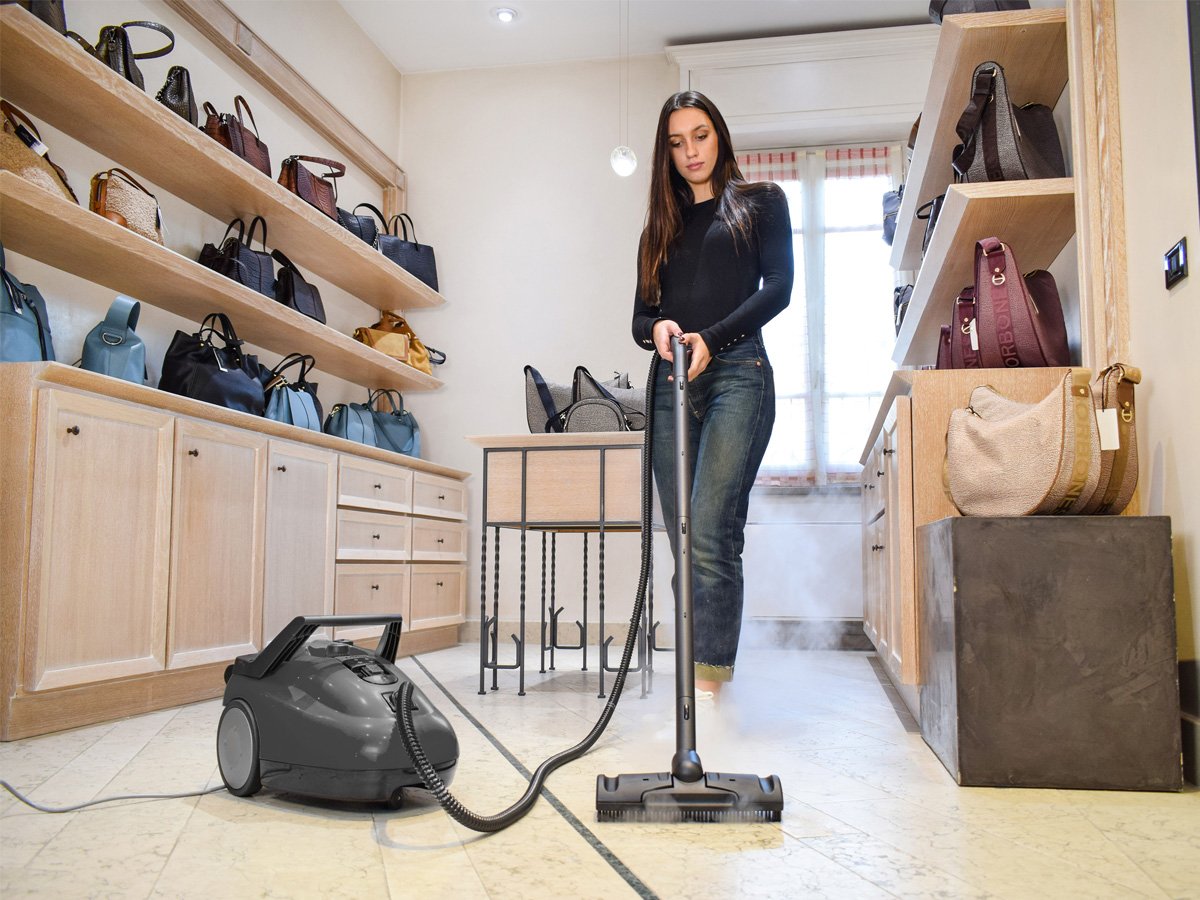Cleaning floor joints: what is the quickest and least tiring way?

Do you spend hours cleaning the surfaces in your home, but the joints are always blackened and full of dirt? You are not alone, and it is not your fault, but the fault of the tools you use!
Floor joints are one of the most difficult areas to keep clean. Made of porous material and often misaligned with the rest of the flooring, they trap dust, grease, moisture, and dirt, which accumulate and make floors look unsightly and untidy, even if they are perfectly clean and sanitized. Similarly, in outdoor spaces such as patios, alleys, and courtyards, flooring can be marred by moss and encrustations which, over time, can damage stones, tiles, and all types of materials.
But what is the quickest and least tiring way to clean joint lines? Choose cleaning equipment that are easy to use but very effective in their results, such as steam cleaners for indoor areas and high pressure cleaners for outdoor spaces.

Why do floor joints get dirty so easily?
Floor joints are one of the most tedious and tiring areas to clean. These grooves between the different tiles making up a surface retain a lot of dirt, which over time becomes unsightly and can even start to emit a bad odour.
The problem of dirt accumulation inside joint lines is linked to several factors:
- They are generally made of mortar, a very porous material that accumulates dirt, but also moisture;
- In bathrooms and kitchens, in addition to accumulating dirt, they can become the perfect place for fungi and mould to proliferate;
- Limescale and soap deposit in spas, bathtubs, showers, but also swimming pools and outdoor flooring, causing them to yellow;
- Food, coarse debris, smog, dust brought in from outside, and all kinds of dirt tend to accumulate in these specific areas, which are generally lower than the floor level.
- In gardens, courtyards, and outdoor areas, in addition to mould and fungi, grass, moss, and lichens can grow on floor joints, further dampening the area and damaging it.
Traditional methods for cleaning joint lines: toothbrushes and detergents
Until now, you have probably used some of the most common traditional methods for cleaning joints, such as toothbrushes, baking soda, vinegar, detergents, or metal sponges. These solutions work, but:
- require a lot of time and physical effort;
- do not ensure thorough sanitization;
- can damage the treated surfaces.
- Steam generators, ideal for cleaning indoor floor;
- High pressure cleaners, effective for quickly removing dirt that accumulates in courtyards, driveways, and patios.
Clean the floor joints in your home quickly with steam
For indoor surfaces, a steam cleaner is the quickest and least tiring method. Thanks to the high-temperature steam jet, it dissolves deep-seated dirt in a matter of seconds, without the need for aggressive chemicals.
Here’s why you should choose a steam generator to clean your floor joints:
- It dissolves encrusted dirt in a matter of seconds;
- It sanitizes naturally, eliminating mould, bacteria, and unpleasant odours;
- It saves time and energy, avoiding long scrubbing sessions;
- It is environmentally friendly because it uses only water.
Furthermore, to speed up your cleaning even more, you can attach the small round brush to the angled spraying gun of your steam cleaner, which will allow you to:
- Direct the steam jet directly onto the joint, multiplying its effectiveness;
- Scrape off encrusted dirt as soon as it melts, effectively removing it even from very porous joint lines.
How to clean indoor floor joints with steam

Cleaning floor joints with a steam cleaner is very simple:
- Use a vacuum cleaner to remove surface dirt from the area;
- Connect the specific accessories for cleaning joint lines to your steam cleaner;
- Slowly direct the jet along the joint lines;
- Dry with a microfiber cloth to complete the cleaning.
In just a few moments, your floor joints will be clean and sanitized again, in line with the care of your entire home, without stress or effort.
An excellent steam cleaner for home use is GV KONE, practical, effective, and equipped with many accessories for high performance on multiple levels.
The outdoor solution: the power of high pressure cleaners
While steam is your number one ally indoors, outdoor high pressure cleaners are the best choice for cleaning floor grout. Outdoor surfaces such as terraces, driveways, courtyards, and stone floors require more power, as dirt is often ingrained between the tiles.
The advantages of using a high pressure cleaner to clean surface grout lines are:
- The high-pressure jet, which removes mud, moss, weeds, and residues even deep down;
- Speed of execution: in just a few minutes, you can effectively clean even large surfaces;
- Versatility. With the right accessories, you can adjust the pressure, improve the effectiveness of the jet, and have the ideal solution for every type of dirt and surface.
With a Lavor high pressure cleaner, you can make your outdoor floors look like new without spending hours scrubbing! And with the right equipment, you can optimize your investment by using the high pressure cleaner for multiple outdoor cleaning tasks, such as:
- Cleaning gutters, downspouts, and drains;
- Cleaning the pool;
- Cleaning your car, bicycles, or motorcycles;
- Cleaning garden furniture;
- And much more!
How to clean outdoor grout with a high pressure cleaner
A high pressure cleaner is a very simple tool to use for cleaning joints:
- Remove coarse dirt with a stiff broom;
- Connect the lance or patio cleaner accessory to the high pressure cleaner;
- Run the jet along the joints, keeping a suitable distance;
- Leave to dry naturally.
...And that’s it!
If you are looking for a complete, versatile, and effective product for cleaning the grout lines of your outdoor flooring and all the exterior surfaces of your home, the Galaxy 160 cold water high pressure cleaner is the right choice for you!
Maintenance: how to keep your grout clean
As we have seen, the structure of floor grout lines facilitates the accumulation of dirt in these specific areas. Here are some tips for keeping your grout lines clean and avoiding unpleasant odours:
- Clean regularly to prevent accumulation;
- In damp environments, use dehumidifiers to limit mould growth.
- Outdoors, if possible, apply a protective sealant to the joints to reduce dirt absorption.
With these small precautions and the support of your new allies against dirt and bacteria, your home and outdoor space will be even cleaner and better cared for, without stress, effort, or wasted time!

.jpg)
